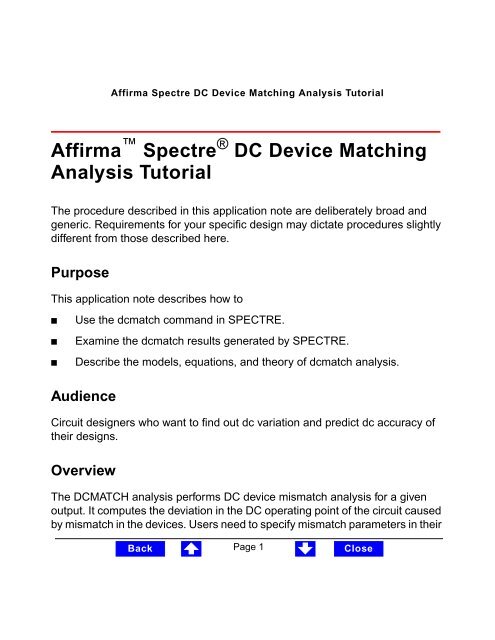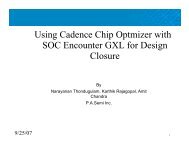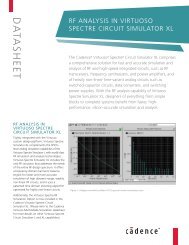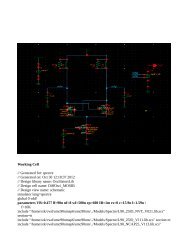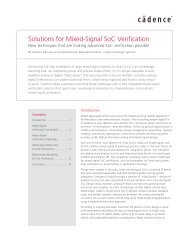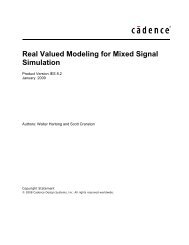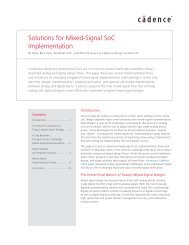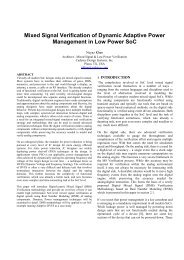Affirma Spectre DC Device Matching Analysis Tutorial - Cadence ...
Affirma Spectre DC Device Matching Analysis Tutorial - Cadence ...
Affirma Spectre DC Device Matching Analysis Tutorial - Cadence ...
Create successful ePaper yourself
Turn your PDF publications into a flip-book with our unique Google optimized e-Paper software.
<strong>Affirma</strong> <strong>Spectre</strong> <strong>DC</strong> <strong>Device</strong> <strong>Matching</strong> <strong>Analysis</strong> <strong>Tutorial</strong><br />
<strong>Affirma</strong> <strong>Spectre</strong> ® <strong>DC</strong> <strong>Device</strong> <strong>Matching</strong><br />
<strong>Analysis</strong> <strong>Tutorial</strong><br />
The procedure described in this application note are deliberately broad and<br />
generic. Requirements for your specific design may dictate procedures slightly<br />
different from those described here.<br />
Purpose<br />
This application note describes how to<br />
■ Use the dcmatch command in SPECTRE.<br />
■ Examine the dcmatch results generated by SPECTRE.<br />
■ Describe the models, equations, and theory of dcmatch analysis.<br />
Audience<br />
Circuit designers who want to find out dc variation and predict dc accuracy of<br />
their designs.<br />
Overview<br />
The <strong>DC</strong>MATCH analysis performs <strong>DC</strong> device mismatch analysis for a given<br />
output. It computes the deviation in the <strong>DC</strong> operating point of the circuit caused<br />
by mismatch in the devices. Users need to specify mismatch parameters in their<br />
Release Date Back Page 1<br />
Close<br />
1
<strong>Affirma</strong> <strong>Spectre</strong> <strong>DC</strong> <strong>Device</strong> <strong>Matching</strong> <strong>Analysis</strong> <strong>Tutorial</strong><br />
model cards for each device contributing to the deviation. The analysis uses the<br />
device mismatch models to construct equivalent mismatch current sources in<br />
parallel to all the devices that have mismatch modeled. These current sources<br />
will have zero mean and some variance. The analysis computes the 3-sigma<br />
variance of dc voltages or currents at user specified outputs due to the<br />
mismatch current sources. The simulation results displays the devices rank<br />
ordered by their contributions to the outputs. In addition, for mosfet devices<br />
(limited to bsim3v3 now), it displays threshold voltage mismatch, current factor<br />
mismatch, gate voltage mismatch, and drain current mismatch. For bipolar<br />
devices (limited to vbic now), it displays base-emitter junction voltage mismatch.<br />
For resistors (limited to two terminal resistance), it displays resistor mismatches.<br />
The analysis replaces multiple simulation runs in the estimation of circuit<br />
accuracies. It automatically identifies the set of critical matched components<br />
during circuit design. For example, when there are matched pairs in the circuit,<br />
the contribution of two matched transistors will be equal in magnitude and<br />
opposite in sign.<br />
Typical usage are to simulate the output offset voltage of operational amplifiers,<br />
estimate the variation in bandgap voltages, and predict the accuracy of current<br />
steering DACs.<br />
Release Date Back Page 2<br />
Close<br />
2
Help syntax<br />
<strong>Affirma</strong> <strong>Spectre</strong> <strong>DC</strong> <strong>Device</strong> <strong>Matching</strong> <strong>Analysis</strong> <strong>Tutorial</strong><br />
To obtain the command syntax on-line, users can type<br />
spectre -h dcmatch<br />
Release Date Back Page 3<br />
Close<br />
3
<strong>Affirma</strong> <strong>Spectre</strong> <strong>DC</strong> <strong>Device</strong> <strong>Matching</strong> <strong>Analysis</strong> <strong>Tutorial</strong><br />
Command syntax<br />
The syntax of the dcmatch analysis is as follows:<br />
Name [pnode nnode] dcmatch ...<br />
where the parameters are<br />
1 mth<br />
Relative mismatch contribution threshold value.<br />
2 where=screen<br />
Where <strong>DC</strong>-Mismatch analysis results should be printed. Possible values<br />
are screen, logfile, file,or rawfile.<br />
3 file<br />
File name for results to be printed if where=file is used.<br />
Probe parameters<br />
4 oprobe<br />
Compute mismatch at the output defined by this component.<br />
Port parameters<br />
5 portv<br />
Release Date Back Page 4<br />
Close<br />
4
<strong>Affirma</strong> <strong>Spectre</strong> <strong>DC</strong> <strong>Device</strong> <strong>Matching</strong> <strong>Analysis</strong> <strong>Tutorial</strong><br />
Voltage across this probe port is output of the analysis. Instead of using<br />
pnode and nnode to identify output, users can use oprobe and portv.<br />
6 porti<br />
Current through this probe port is output of the analysis.<br />
Notice that porti allows users to select a current associated with a specific<br />
device (component) given in oprobe as an output. This device, however,<br />
has to have its terminal current(s) as network variable(s), i.e. the device<br />
has to be an inductor, a switch, a tline, a controlled voltage source, an<br />
iprobe, or other type of device which has branch currents as network<br />
variables. Otherwise, <strong>Spectre</strong> will invalidate the request. Furthermore, for<br />
inductor, vsource, switch, controlled voltage source and iprobe, porti can<br />
only be set to one, since these devices are one port devices (two terminal);<br />
and for tline porti can be set to one or two, since it is a two port device (four<br />
terminals).<br />
Sweep interval parameters<br />
7 start=0<br />
Start sweep limit.<br />
8 stop<br />
Stop sweep limit.<br />
9 center<br />
Center of sweep.<br />
10 span=0<br />
Sweep limit span.<br />
Release Date Back Page 5<br />
Close<br />
5
11 step<br />
<strong>Affirma</strong> <strong>Spectre</strong> <strong>DC</strong> <strong>Device</strong> <strong>Matching</strong> <strong>Analysis</strong> <strong>Tutorial</strong><br />
Step size, linear sweep.<br />
12 lin=50<br />
Number of steps, linear sweep.<br />
13 dec<br />
Points per decade.<br />
14 log=50<br />
Number of steps, log sweep.<br />
15 values=[...]<br />
Array of sweep values.<br />
Sweep variable parameters<br />
16 dev<br />
<strong>Device</strong> instance whose parameter value is to be swept.<br />
17 mod<br />
Model whose parameter value is to be swept.<br />
18 param<br />
Name of parameter to sweep.<br />
Release Date Back Page 6<br />
Close<br />
6
<strong>Affirma</strong> <strong>Spectre</strong> <strong>DC</strong> <strong>Device</strong> <strong>Matching</strong> <strong>Analysis</strong> <strong>Tutorial</strong><br />
State-file parameters<br />
19 readns<br />
File that contains estimate of <strong>DC</strong> solution (nodeset).<br />
Output parameters<br />
20 save<br />
Signals to output. Possible values are all, lvl, allpub, lvlpub, selected, or<br />
none.<br />
21 nestlvl<br />
Levels of subcircuits to output.<br />
22 oppoint=no<br />
Should operating point information be computed, and if so, where should it<br />
be sent. Possible values are no, screen, logfile, or rawfile.<br />
Convergence parameters<br />
23 prevoppoint=no<br />
Use operating point computed on the previous analysis. Possible values<br />
are no or yes.<br />
24 restart=yes<br />
Do not use previous <strong>DC</strong> solution as initial guess. Possible values are no or<br />
yes.<br />
Release Date Back Page 7<br />
Close<br />
7
<strong>Affirma</strong> <strong>Spectre</strong> <strong>DC</strong> <strong>Device</strong> <strong>Matching</strong> <strong>Analysis</strong> <strong>Tutorial</strong><br />
Annotation parameters<br />
25 annotate=sweep<br />
Degree of annotation. Possible values are no, title, sweep, status, or steps.<br />
26 stats=no<br />
<strong>Analysis</strong> statistics. Possible values are no or yes.<br />
27 title<br />
<strong>Analysis</strong> title.<br />
The dcmatch analysis will find a dc operating point first. If the dc analysis fails,<br />
then the dcmatch analysis will fail also. The parameter mth is a threshold value<br />
relative to the maximum contribution. Any device contribution less than (mth *<br />
maximum) will not be reported. Where maximum is the maximum contribution<br />
among all the devices of a given type.<br />
Release Date Back Page 8<br />
Close<br />
8
Example<br />
<strong>Affirma</strong> <strong>Spectre</strong> <strong>DC</strong> <strong>Device</strong> <strong>Matching</strong> <strong>Analysis</strong> <strong>Tutorial</strong><br />
dcmm1 dcmatch mth=1e-3 oprobe=vd porti=1<br />
model n1 bsim3v3 type=n ...<br />
+ mvtwl=6.15e-9 mvtwl2=2.5e-12 mvt0=0.0 mbewl=16.5e-9 mbe0=0.0<br />
In the above example, a dcmatch analysis is to be performed to investigate the<br />
3-sigma dc variation at the output of the current flowing through the device vd.<br />
The porti=1 specifies that the current is flowing through the first port of vd (vd<br />
has only one port obviously, thus porti=2 will be illegal). All device mismatch<br />
contributions less than 1e-3 * maximum contribution among devices to the<br />
output will not be reported. dcmm1 is the name of the analysis, which can be<br />
used to identify output among analyses. The mismatch (i.e. the equivalent<br />
mismatch current sources in parallel to all the devices that uses model n1) is<br />
modeled by the model parameters mvtwl, mvtwl2, mvt0, mbewl, and mbe0. The<br />
meaning of these parameters is described in the modeling section.<br />
The output of the dcmatch analysis is displayed like this:<br />
*********************************************<br />
<strong>DC</strong> <strong>Device</strong> <strong>Matching</strong> <strong>Analysis</strong> ‘mismatch1’ at vd<br />
*********************************************<br />
Local Variation = 3-sigma random device variation<br />
Release Date Back Page 9<br />
Close<br />
9
<strong>Affirma</strong> <strong>Spectre</strong> <strong>DC</strong> <strong>Device</strong> <strong>Matching</strong> <strong>Analysis</strong> <strong>Tutorial</strong><br />
sigmaOut sigmaVth sigmaBeta sigmaVg sigmaIds<br />
-13.8 uA 2.21 mV 357 m% 2.26 mV 1.71 % mp6<br />
-6.99 uA 1.63 mV 269 m% 1.68 mV 1.08 % m01<br />
-2.71 uA 1.11 mV 187 m% 1.16 mV 648 m% m02<br />
-999 nA 769 uV 131 m% 807 uV 428 m% m04x4_4<br />
-999 nA 769 uV 131 m% 807 uV 428 m% m04x4_3<br />
-999 nA 769 uV 131 m% 807 uV 428 m% m04x4_2<br />
-999 nA 769 uV 131 m% 807 uV 428 m% m04x4_1<br />
-999 nA 769 uV 131 m% 807 uV 428 m% m04<br />
-718 nA 1.09 mV 185 m% 1.15 mV 599 m% m40x04<br />
-520 nA 1.55 mV 263 m% 1.63 mV 835 m% m20x04<br />
-378 nA 2.21 mV 376 m% 2.34 mV 1.16 % m10x04<br />
-363 nA 539 uV 92 m% 567 uV 293 m% m08<br />
-131 nA 379 uV 64.9 m% 400 uV 203 m% m16<br />
-46.7 nA 267 uV 45.9 m% 283 uV 142 m% m32<br />
Release Date Back Page 10<br />
Close<br />
10
<strong>Affirma</strong> <strong>Spectre</strong> <strong>DC</strong> <strong>Device</strong> <strong>Matching</strong> <strong>Analysis</strong> <strong>Tutorial</strong><br />
vd =-3.477 mA +/- 15.91 uA (3-sigma variation)<br />
It says that the 3-sigma variation at i(vdd) is -3.477mA +/- 15.91uA due to the<br />
mismatch models. The -3.477mA is the dc operating value of the i(vdd),<br />
whereas the 15.91uA is the 3-sigma variation due to the device mismatches.<br />
The device mp6 contributes the most to the output at<br />
-13.8 uA followed by m01 which contributes -6.99uA. The equivalent 3-sigma<br />
Vth variation of mp6 is 2.21mV. The relative 3-sigma beta (current factor)<br />
variation of mp6 is 0.357%. The equivalent 3-sigma gate voltage variation<br />
is 2.26mV. The relative 3-sigma Ids variation of mp6 is 1.71%.<br />
Release Date Back Page 11<br />
Close<br />
11
More Examples<br />
<strong>Affirma</strong> <strong>Spectre</strong> <strong>DC</strong> <strong>Device</strong> <strong>Matching</strong> <strong>Analysis</strong> <strong>Tutorial</strong><br />
dcmm2 n1 n2 dcmatch mth=1e-3 where=rawfile stats=yes<br />
In the above example, a dcmatch analysis is to be performed to investigate the<br />
3-sigma dc variation on output v(n1,n2). The result of the analysis will be printed<br />
in a psf file. The cpu statistics of the analysis will also be generated.<br />
dcmm3 dcmatch mth=1e-3 oprobe=r3 portv=1<br />
In the above example, the output is the voltage drop across the 1st port of r3.<br />
Since r3 has only one port, portv=2 will be illegal.<br />
dcmm4 n3 0 dcmatch mth=1e-3 where=file file="%C:r.info.what"<br />
In the above example, the output of the analysis will be printed in a file of<br />
.info.what prepended with circuit name.<br />
sweep1 sweep dev=mp6 param=w start=80e-6 stop=90e-6 step=2e-6 {<br />
dcmm5 n3 0 dcmatch mth=1e-3 where=rawfile<br />
}<br />
In the above example, a set of analyses will be performed on output v(n3,0) by<br />
sweeping the device parameter w of the device mp6 from 80um to 90um at each<br />
increment of 2um. The results will be printed as psf files. The psf files will be<br />
named as sweep1-000_dcmm5.dcmatch to sweep1-005_dcmm5.dcmatch.<br />
dcmm6 n3 0 dcmatch mth=0.01 dev=x1.mp2 param=w<br />
+ start=15e-6 stop=20e-6 step=1e-6 where=rawfile<br />
Release Date Back Page 12<br />
Close<br />
12
<strong>Affirma</strong> <strong>Spectre</strong> <strong>DC</strong> <strong>Device</strong> <strong>Matching</strong> <strong>Analysis</strong> <strong>Tutorial</strong><br />
In the above example, an internal sweep of dcmatch analyses will be performed<br />
by sweeping the device parameter w of the device x1.mp2 from 15um to 20um<br />
at each increment of 1um. The results will be printed as psf files. The psf files<br />
will be named as dcmm6_0.dcmatch to dcmm6_5.dcmatch. Notice that even<br />
it is an internal sweep, six files still will be generated. This is contradictory to a<br />
dc or an ac analysis, where only a single psf file is generated while sweeping a<br />
parameter. This is due to the fact while sweeping a parameter, the rank order of<br />
the output contribution for each devices may become different. Thus we need to<br />
store the results in multiple psf files.<br />
dcmm7 n3 0 dcmatch mth=0.01 param=temp<br />
+ start=25 stop=100 step=25<br />
In the above example, temperature is swept from 25C to 100C at increment of<br />
25C.<br />
Release Date Back Page 13<br />
Close<br />
13
<strong>Affirma</strong> <strong>Spectre</strong> <strong>DC</strong> <strong>Device</strong> <strong>Matching</strong> <strong>Analysis</strong> <strong>Tutorial</strong><br />
Mismatch modeling<br />
1. Use Model<br />
After identifying the output, the user needs to specify the parameters for each device<br />
contributing to the mismatch. Currently, The mismatch model implemented in <strong>Spectre</strong> for<br />
Mosfet transistors introduces five additional model parameters, one for bjts and nine for<br />
resistors.<br />
To start the dc-mismatch analysis, the user types the analysis statement with the output<br />
voltage on which the dc-mismatch analysis is to be performed. The results are:<br />
1) The 3-sigma random output variation<br />
2) The dc operating point information<br />
3) For each Mosfet:<br />
• 3-sigma output variation,<br />
• 3-sigma Beta variation,<br />
• 3-sigma Threshold voltage variation, 3σ(ΔVth)<br />
• 3-sigma gate voltage variation, 3σ(ΔVg)<br />
• 3-sigma current mismatch to nominal current ratio,<br />
4) For each BJT<br />
• 3-sigma output variation,<br />
∂<br />
3σ( ΔIds)<br />
Vout<br />
∂ΔIds<br />
3σ( Δβ)<br />
-----------------β0<br />
∂<br />
3σ( ΔIc)<br />
Vout<br />
∂ΔIc<br />
• 3-sigma Vbe Variation, 3σ(ΔVbe)<br />
3σ( ΔIds)<br />
-----------------------<br />
Ids0 Release Date Back Page 14<br />
Close<br />
14
5) For each Resistor<br />
<strong>Affirma</strong> <strong>Spectre</strong> <strong>DC</strong> <strong>Device</strong> <strong>Matching</strong> <strong>Analysis</strong> <strong>Tutorial</strong><br />
• 3-sigma output variation,<br />
• 3-sigma Resistor current mismatch to nominal resistance current ratio,<br />
• 3-sigma VR variation, 3σ(ΔVr) = 3σ(ΔIr).R<br />
• 3-sigma IR variation, 3σ(ΔIr)<br />
• 3-sigma Resistor variation,<br />
We define a threshold mth, below which the contributions will not be shown, currently, in<br />
spectre mth = 0.1%. Mth is an analysis parameter.<br />
2. Summary of Theory.<br />
Statistical variation of drain current in a MOSFET is modeled by:<br />
where:<br />
Ids<br />
Ids o<br />
ΔIds<br />
∂<br />
3σ( ΔIr)<br />
Vout<br />
∂ΔIr<br />
3 σΔIr ( )<br />
----------------R<br />
Ir0 ds = Idso+ ΔIds<br />
-- is the total drain to source current.<br />
-- is the nominal current.<br />
3σ( ΔIr)<br />
--------------------<br />
Ir0 , (EQ 1)<br />
-- is the variation in drain to source current due to local device variation.<br />
Let Vout be the output signal of interest, then the variance of Vout due to the i<br />
MOSFET is approximated by:<br />
th<br />
Vout)i<br />
⎛ ∂<br />
Vout⎞<br />
⎝∂ΔIds ⎠<br />
i<br />
2<br />
=<br />
(EQ 2)<br />
Release Date Back Page 15<br />
Close<br />
15<br />
Ids o<br />
σ2( ΔIdsi)
<strong>Affirma</strong> <strong>Spectre</strong> <strong>DC</strong> <strong>Device</strong> <strong>Matching</strong> <strong>Analysis</strong> <strong>Tutorial</strong><br />
∂<br />
The term Vout in (2) is the sensitivity of the output to the drain to source current<br />
∂ΔIdsi<br />
and can be efficiently obtained in a standard way as outlined in part b.<br />
a- Mismatch models<br />
The term σ is the variance of the mismatch current in Mosfet transistors. The<br />
mismatch in the current is assumed to be due to a mismatch in the threshold voltage<br />
( ) and the mismatch in the width to length ratio ( ). It is approximated as:<br />
2( ΔIdsi) Vth β<br />
where<br />
gm o<br />
= ∂Ids<br />
----------- ,<br />
∂Vth<br />
Idso<br />
2<br />
gmo σ2( ΔIds)<br />
( Ids0) 2<br />
----------------------<br />
( Ids0) 2<br />
-----------------σ 2 σ<br />
( ΔVth)<br />
2( Δβ)<br />
=<br />
+ -----------------<br />
2<br />
βo and currently, as implemented in <strong>Spectre</strong>:<br />
σ2( ΔVth)<br />
σ2( Δβ)<br />
( β0)<br />
2<br />
----------------- =<br />
=<br />
mvtwl 2<br />
-----------------<br />
WL<br />
mvtwl22<br />
WL2 -------------------- mvt0 2<br />
+ +<br />
mbewl 2<br />
------------------ mbe0<br />
WL<br />
2<br />
+<br />
, (EQ 3)<br />
Note, that gmo is computed at the <strong>DC</strong> bias solution from the device model equations,<br />
the values a, b, c, d and e are the mismatch parameters while W and L<br />
are device<br />
parameters.<br />
Another way of representing the mismatch current is using the gate voltage variation<br />
defined as:<br />
Release Date Back Page 16<br />
Close<br />
16
<strong>Affirma</strong> <strong>Spectre</strong> <strong>DC</strong> <strong>Device</strong> <strong>Matching</strong> <strong>Analysis</strong> <strong>Tutorial</strong><br />
Similarly to the Mosfet, the bipolar σ and the resistor are computed for<br />
each device provided that the device size, bias point and mismatch parameters are<br />
known.<br />
2( ΔIci)<br />
σ2( ΔIri)<br />
where gm0 is and Ic0 is the nominal collector current, and ΔVbe =(mvt0) 2<br />
∂<br />
Ic<br />
b-Mismatch analysis<br />
(EQ 4)<br />
∂<br />
The goal is to compute Vout for each MOSFET i . The network is characterized<br />
∂ΔIdsi<br />
with the standard MNA equations with the addition of the term for the mismatch<br />
current:<br />
where:<br />
-- is the vector of equations,<br />
x<br />
-- is the vector of unknowns,<br />
σ 2 ( ΔVg)<br />
σ2( ΔIds)<br />
≡ ----------------------<br />
2<br />
gmo σ2( ΔIr)<br />
mrl<br />
------------------- mr<br />
Ir2 0 Lmrlp mrw------------<br />
W mrwp<br />
mrlw1mrlw2 = + + ---------------- + ------------------------------ + ------------------------------<br />
( LW)<br />
mrlw1 p ( LW ) mrlw2 p<br />
σ2( ΔIc)<br />
( Ic0) 2<br />
------------------- =<br />
f<br />
( gm0) 2<br />
( Ic0) 2<br />
˙<br />
----------------- ( mvt0)<br />
2 ⋅<br />
∂VBE<br />
∑ i<br />
( x)<br />
+ m ΔIdsi = 0<br />
i<br />
, (EQ 5)<br />
Release Date Back Page 17<br />
Close<br />
17
<strong>Affirma</strong> <strong>Spectre</strong> <strong>DC</strong> <strong>Device</strong> <strong>Matching</strong> <strong>Analysis</strong> <strong>Tutorial</strong><br />
ΔIdsi -- is the mismatch current of the i MOSFET,<br />
th<br />
mi -- is incidence column vector that maps the mismatch current of the ith device to<br />
the proper MNA equations.<br />
The output is defined as:<br />
, (EQ 6)<br />
where y is a column vector and superscript “T” represents the transpose.<br />
In terms of (6), the sensitivity becomes:<br />
∂x<br />
The term ---------------- is obtained by differentiating (5) with respect to ΔIds --<br />
∂ΔIds<br />
i<br />
i<br />
and then solving<br />
Vout y T = x<br />
∂<br />
T x<br />
Vout y . (EQ 7)<br />
∂ΔIdsi<br />
∂<br />
= ----------------<br />
∂ΔIdsi<br />
∂ f( x)<br />
∂x<br />
-------------- ---------------- + m , (EQ 8)<br />
∂x<br />
∂ΔIds<br />
i = 0<br />
i<br />
∂x<br />
∂ f( x)<br />
---------------- = – --------------<br />
∂ΔIdsi<br />
∂x<br />
Combining (9) with (7), the expression for sensitivity becomes:<br />
∂<br />
∂ΔIdsi<br />
Vout – y<br />
T f x ( ) ∂<br />
=<br />
--------------<br />
∂x<br />
– 1<br />
mi . (EQ 9)<br />
– 1<br />
mi Since there is only one output and many MOSFETS, it is efficient to define a<br />
(EQ 10)<br />
Release Date Back Page 18<br />
Close<br />
18
<strong>Affirma</strong> <strong>Spectre</strong> <strong>DC</strong> <strong>Device</strong> <strong>Matching</strong> <strong>Analysis</strong> <strong>Tutorial</strong><br />
vector z such that<br />
or<br />
(EQ 11)<br />
(EQ 12)<br />
After computing the vector z through a “transpose solve” in (12), the sensitivity of the<br />
output with respect to each transistor current can be computed with one extra vector<br />
product:<br />
(EQ 13)<br />
and finally, σ would be the variance of the output, where n is<br />
2( Vout)<br />
zT ( mi) 2 σ2 =<br />
∑ ( ΔIdsi) the number of devices.<br />
z T<br />
∂<br />
ΔIdsi In the equations above, the bjt and the resistor contributions to the mismatch should<br />
be added.<br />
3. Finding Model Parameters.<br />
n<br />
i = 1<br />
=<br />
T f( x)<br />
y ∂<br />
--------------<br />
∂x<br />
∂ f( x)<br />
--------------<br />
∂x<br />
T<br />
z = y<br />
To determine dcmatch model parameters, users have to go to their foundry or<br />
modeling group, study the statistical process, then do a regression analysis. We will<br />
give an example of how to use the concept of curve fitting to find model parameters.<br />
The actual procedure may vary significantly and is a matter of art. We will only<br />
introduce the concept. In general, to find parameters is not a trivial task.<br />
Lets assume we want to find out the parameters mvtwl, mvtwl2, and mvt0, which are<br />
used in the model equation<br />
Release Date Back Page 19<br />
Close<br />
19<br />
– 1<br />
Vout – z<br />
T = mi
<strong>Affirma</strong> <strong>Spectre</strong> <strong>DC</strong> <strong>Device</strong> <strong>Matching</strong> <strong>Analysis</strong> <strong>Tutorial</strong><br />
σ2( ΔVth)<br />
=<br />
mvtwl 2<br />
-----------------<br />
WL<br />
mvtwl22<br />
WL2 -------------------- mvt0 2<br />
+ +<br />
(EQ 14)<br />
The modeling group needs to make, say 200 statistical measurements of the values<br />
of σ by varying values of channel length L and width W. Provided that threshold<br />
voltage extraction is a known procedure. Typically, threshold voltage is the value of<br />
gate voltage that corresponds to a drain current of 1mA. Extraction of this parameter<br />
is done at low drain bias (about 0.1V) although in modern technologies this value may<br />
be even lower. Gate bias is increased gradually until this level of current is achieved.<br />
After the 200 samples are collected, the task becomes to find parameters p1, p2, and<br />
p3 to minimize the curve fitting error via the least square fit formula:<br />
2 ( ΔVth)<br />
⎛ ⎛ p1 p2 ⎞⎞<br />
error ⎜yi– ⎜----------- + ------------- + p<br />
W iL 2 3⎟⎟<br />
⎝ ⎝ i W iL ⎠⎠<br />
i<br />
2<br />
200<br />
= ∑<br />
i = 1<br />
(EQ 15)<br />
where yi is the i-th measurement value (among the 200 measurements) of σ at<br />
and . Once the p1, p2, and p3 are found, we can take the square root of<br />
them to find mvtwl, mvtwl2 and mvt0, repectively. The minimum of error in Equation<br />
(15) occurs where the derivative of error with respect to p1, p2, and p3 vanishes.<br />
2 ( ΔVth)<br />
L = Li W = Wi 200<br />
∂ ⎛ ⎛ p1 p2 ⎞⎞<br />
– 1<br />
error = 2 yi ------------<br />
∂ p ∑ ⎜ – ⎜ + ------------- + p<br />
1<br />
W iL 2 3⎟⎟-----------<br />
=<br />
⎝ ⎝ i W iL ⎠⎠WiLi<br />
i = 1<br />
i<br />
200<br />
∂ ⎛ ⎛ p1 p2 ⎞⎞<br />
– 1<br />
error = 2 yi ------------<br />
∂ p ∑ ⎜ – ⎜ + ------------- + p<br />
2<br />
W iL 2 3⎟⎟------------<br />
=<br />
⎝ ⎝ i W iL ⎠⎠<br />
2<br />
i = 1<br />
i<br />
W iLi (EQ 16)<br />
(EQ 17)<br />
Release Date Back Page 20<br />
Close<br />
20<br />
0<br />
0
<strong>Affirma</strong> <strong>Spectre</strong> <strong>DC</strong> <strong>Device</strong> <strong>Matching</strong> <strong>Analysis</strong> <strong>Tutorial</strong><br />
200<br />
∂ ⎛ ⎛ p1 p2 ⎞⎞<br />
error = 2 yi ------------<br />
∂ p ∑ ⎜ – ⎜ + ------------- + p<br />
3<br />
W iL 2 3⎟⎟(<br />
– 1)<br />
=<br />
⎝ ⎝ i W iL ⎠⎠<br />
i = 1<br />
i<br />
The Equations (16), (17), and (18) can be rearranged in normal form as:<br />
∑<br />
∑<br />
∑<br />
1<br />
--------------<br />
2 2<br />
W i<br />
Li<br />
1<br />
--------------<br />
2 3<br />
W i<br />
Li<br />
1<br />
------------<br />
W iLi ∑<br />
∑<br />
∑<br />
1<br />
--------------<br />
2 3<br />
W i<br />
Li<br />
1<br />
--------------<br />
2 4<br />
W i<br />
Li<br />
1<br />
-------------<br />
2<br />
W iLi (EQ 18)<br />
(EQ 19)<br />
Assuming that the matrix in the Equation (19) is not singular, then (19) can be solved<br />
for p1, p2, and p3, using standard LU decomposition and backsubstitution. If the<br />
matrix is singular, then different method such as singular value decomposition can be<br />
used. The model parameters mvtwl, mvtwl2, and mvt0 are simply the square root of<br />
the p1, p2, and p3, respectively.<br />
As for illustration, we attach a sample C program here. The first half portion of the<br />
program is to cook up 200 sample data points of yi to mimic measurement data. We<br />
also create the right hand side vector rhs<br />
as in Equation (19). The last half portion<br />
creates the matrix, and calls dense matrix solver routines dgeco and dgesl from<br />
LINPACK (a popular dense matrix package) to obtain the fitted parameters. Upon<br />
executing the program, we got this result:<br />
model parameter mvtwl = 0.01<br />
model parameter mvtwl2 = 0.003<br />
model parameter mvt0 = 0<br />
∑<br />
∑<br />
1<br />
------------<br />
W iLi 1<br />
-------------<br />
2<br />
W iLi ∑1<br />
Release Date Back Page 21<br />
Close<br />
21<br />
p 1<br />
p 2<br />
p 3<br />
=<br />
∑<br />
∑<br />
yi ------------<br />
W iLi yi -------------<br />
2<br />
W iLi ∑ yi 0
<strong>Affirma</strong> <strong>Spectre</strong> <strong>DC</strong> <strong>Device</strong> <strong>Matching</strong> <strong>Analysis</strong> <strong>Tutorial</strong><br />
generating 200 samples using the above parameters ...<br />
fitted parameter 0 = 0.0102933<br />
fitted parameter 1 = 0.00290799<br />
fitted parameter 2 = 0<br />
The program is by no means to be robust or efficient. Nevertheless, it illustrates the<br />
concept of curve fitting. The exact procedure for fitting your measurements to obtain<br />
proper model parameters robustly has to be developed by your modeling group.<br />
#include <br />
#include <br />
#include <br />
#define F77CONV(array,i,j,lda) (array[ (i) + (lda) * (j) ])<br />
main() {<br />
int i, j, k, samples, n, lda, one, zero;<br />
double y, sigmavth2; /* sigma^2(dvth) */<br />
double mvtwl, mvtwl2, mvt0;<br />
double w, l;<br />
double r, t, rcond, tmp;<br />
double alpha[3][3], rhs[3], work[3];<br />
double farray[9];<br />
int ipvt[3];<br />
double drand_();<br />
/* the following are the model parameters to fit */<br />
Release Date Back Page 22<br />
Close<br />
22
}<br />
<strong>Affirma</strong> <strong>Spectre</strong> <strong>DC</strong> <strong>Device</strong> <strong>Matching</strong> <strong>Analysis</strong> <strong>Tutorial</strong><br />
mvtwl = 10e-3;<br />
mvtwl2 = 3e-3;<br />
mvt0 = 0;<br />
printf(" model parameter mvtwl = %g\n", mvtwl);<br />
printf(" model parameter mvtwl2 = %g\n", mvtwl2);<br />
printf(" model parameter mvt0 = %g\n", mvt0);<br />
n = lda = 3;<br />
samples = 200;<br />
zero = 0;<br />
printf(" generating %d samples using the above parameters ...\n",samples);<br />
for (i = 0; i
<strong>Affirma</strong> <strong>Spectre</strong> <strong>DC</strong> <strong>Device</strong> <strong>Matching</strong> <strong>Analysis</strong> <strong>Tutorial</strong><br />
k++;<br />
l = 0.36;<br />
w = 1.0 * k;<br />
}<br />
sigmavth2 = mvtwl*mvtwl/(w*l) + mvtwl2*mvtwl2/(w*l*l) + mvt0*mvt0;<br />
r = drand_(&zero)*5e-2;<br />
/* generate fake measurement data */<br />
y = (1.0 +r) * sigmavth2;<br />
/* create least square fit right rhs */<br />
rhs[0] += y/(w*l);<br />
rhs[1] += y/(w*l*l);<br />
rhs[2] += y;<br />
}<br />
/********************************************/<br />
/* portion2: solve for p */<br />
/********************************************/<br />
/* create the curve fittling matrix */<br />
l = 0.18;<br />
k = 0;<br />
for (i = 0; i= samples/2) {<br />
k++;<br />
l = 0.36;<br />
w = 1.0 * k;<br />
}<br />
Release Date Back Page 24<br />
Close<br />
24
}<br />
<strong>Affirma</strong> <strong>Spectre</strong> <strong>DC</strong> <strong>Device</strong> <strong>Matching</strong> <strong>Analysis</strong> <strong>Tutorial</strong><br />
tmp = 1.0/(w*l);<br />
alpha[0][0] += (tmp*tmp);<br />
alpha[0][1] += (tmp*tmp)/l;<br />
alpha[0][2] += tmp;<br />
alpha[1][0] += (tmp*tmp)/l;<br />
alpha[1][1] += (tmp*tmp)/(l*l);<br />
alpha[1][2] += (tmp/l);<br />
alpha[2][0] += tmp;<br />
alpha[2][1] += tmp/l;<br />
alpha[2][2] += 1.0;<br />
/* convert to fortran array, since we will be calling fortran solvers */<br />
for (i = 0; i < n; i++) {<br />
for (j = 0; j < n; j++) {<br />
F77CONV( farray, i, j, lda ) = alpha[i][j];<br />
}<br />
}<br />
/* solve the matrix to obtain the three fitted model parameters */<br />
dgeco_( farray, &n, &lda, ipvt, &rcond, work);<br />
t = 1.0 + rcond;<br />
if (t == 1.0) {<br />
printf("singluar matrix of alpha encountered rcond = %g\n",rcond);<br />
}<br />
dgesl_( farray, &n, &lda, ipvt, rhs, &zero);<br />
Release Date Back Page 25<br />
Close<br />
25
}<br />
<strong>Affirma</strong> <strong>Spectre</strong> <strong>DC</strong> <strong>Device</strong> <strong>Matching</strong> <strong>Analysis</strong> <strong>Tutorial</strong><br />
/* after dgesl, rhs contains p1, p2, p3 now */<br />
printf("\n");<br />
for (i = 0; i< 3; i++) {<br />
if (rhs[i] = 0) {<br />
printf(" fitted parameter %d = %g\n", i, sqrt(rhs[i]));<br />
}<br />
}<br />
Release Date Back Page 26<br />
Close<br />
26


